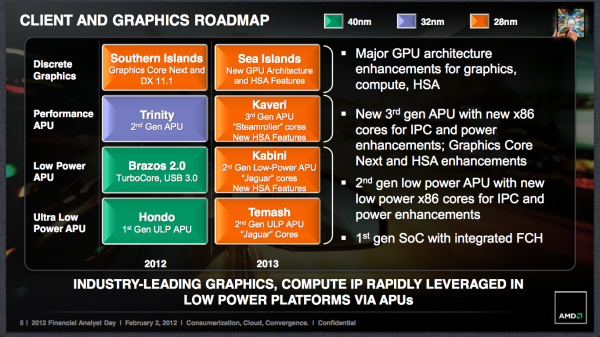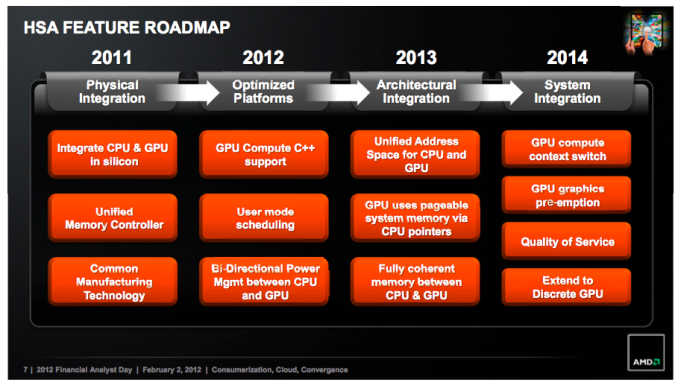AMD Radeon HD 7790 Review Feat. Sapphire: The First Desktop Sea Islands
by Ryan Smith on March 22, 2013 12:01 AM EST- Posted in
- GPUs
- AMD
- Sapphire
- GCN
- Radeon HD 7000
Bonaire’s Microarchitecture - What We’re Calling GCN 1.1
With our introduction out of the way, before looking at the cards and our performance results we would like to dive into a technical discussion and a bit of nitpicking. Specifically we would like to spend some time talking about architectures and product naming, as it’s going to be a bit confusing at first. As AMD has stated numerous times in the past, Graphics Core Next is a long-term architecture for the company. AMD intends to evolve GCN over the years, releasing multiple microarchitectures based on GCN that improve the architecture and add features while still being rooted in the design principles of GCN. GCN is after all the other half of AMD’s upcoming HSA-capable APUs, the culmination of years of AMD’s efforts with HSA/Fusion.
So where does Bonaire fit in? Bonaire is of course a GCN part; it’s a new microarchitecture that’s technically different from Southern Islands, but on the whole it’s a microarchitecture that’s extremely close in design to Southern Islands. In this new microarchitecture there are some changes – among other things the new microarchitecture implements some new instructions that will be useful for HSA, support for a larger number of compute work queues (also good for HSA) and it also implements a new version of AMD’s PowerTune technology (which we’ll get to in a bit) – but otherwise the differences from Southern Islands are very few. There are no notable changes in shader/CU efficiency, ROP efficiency, graphics features, etc. Unless you’re writing compute code for AMD GPUs, from what we know about this microarchitecture it’s likely you’d never notice a difference.
Unfortunately AMD has chosen to more-or-less gloss over the microarchitectural differences altogether, which is not wholly surprising since they will be selling Bonaire and previous generation products side-by-side. Bonaire’s microarchitecture has no official name (at least not one AMD wants to give us) and no version number. The Sea Islands name we’ve been seeing thrown around is not the microarchitecture name. Sea Islands is in fact the name for all of the GPUs in this wave – or perhaps it would be better to say all of the products created in this development cycle – including both Bonaire and it’s new microarchitecture, and Oland, AMD’s other new GPU primarily for mobile that is purely Southern Islands in microarchitecture.

In fact if not for the fact that AMD released (and then retracted) an ISA document called “AMD Sea Islands Instruction Set Architecture” last month, we would likely know even less about Bonaire’s microarchitecture. The document has been retracted at least in part due to the name (since AMD will not be calling the microarchitecture Sea Islands after all), so as a whole AMD isn’t particularly keen in talking about their microarchitecture at this time. But at the same time from a product standpoint it gives you an idea of how AMD is intending to smoothly offer both Southern Islands and Bonaire microarchitecture parts together as one product family.
Anyhow, for the sake of our sanity and for our discussions, in lieu of an official name from AMD we’re going to be retroactively renaming AMD’s GCN microarchitectures in order to quickly tell them apart. For the rest of this article and in future articles we will be referring to Southern Islands as GCN 1.0, while Bonaire’s microarchitecture will be GCN 1.1, to reflect the small changes between it and the first rendition of GCN.
Ultimately the differences between GCN 1.0 and GCN 1.1 are extremely minor, but they are real. But despite our general annoyance in how this has been handled, for consumers the difference between a GCN 1.0 card like the 7770 and a GCN 1.1 card like the 7790 should be limited to their innate performance differences, and of course PowerTune. GCN 1.1 or not, Bonaire fits in nicely in AMD’s current product stack and is in a position where it’s reasonable for it to be lumped together with GCN 1.0 parts as a single family. It’s really only the technical enthusiasts (like ourselves) and programmers that should have any significant reason to care about GCN 1.0 versus GCN 1.1. For everyone else this may just as well be another Southern Islands part.











107 Comments
View All Comments
Sabresiberian - Monday, March 25, 2013 - link
A roadmap is nothing but a projection of what is PLANNED for the future, not some kind of "promise" or "guarantee". Calling AMD people liars because the released product didn't match the projection is childish at best.And before you slap the "fanboy" label on me, I prefer Nvidia generally speaking (but I'm not going to cut off my proverbial nose to spite my face in order to be brand loyal; if AMD has the current best solution for my purposes, I'm going to buy AMD).
CeriseCogburn - Saturday, March 23, 2013 - link
128 bit bus is great, the HD5770 proved that.BWHAHAHHAAA
dishayu - Friday, March 22, 2013 - link
Good eye. But then they metion HD7790 as Pitcairn LE in that infographic. What they have launched as HD7790 now is Bonaire.ShieTar - Friday, March 22, 2013 - link
Maybe they surprised themselves by getting GDDR5 to run at 6GHz, and realized that they can stick with 128bit at that speed?Lonyo - Friday, March 22, 2013 - link
They were going to use a cutdown Pitcairn, being 7870/7850 GPU, and cut down the GPU core to use excess cores that couldn't make the cut as 7870/7850s.They might have gone with 256-bit to simplify the product for AIB partners who could just re-use their HD7850 designs, rather than needing a new design for a smaller run product.
The 7790 now is a new GPU designed to be cheaper to produce (as it's smaller) than Pitcairn, and the fact the memory can run at 6GHz is probably due in part to the fact it's a new GPU rather than a cut down Pitcairn.
CeriseCogburn - Friday, March 22, 2013 - link
I don't see a launch date in the whole article, it's NOT available. I guess that's another mystery freebie for AMD's products here.Didn't see port config either, so what cabling do we have to buy to run 3 monitors when Asus 650ti runs 4 out of the box, 3 with dvi and vga only ?
Not impressed with the huge AMD biased game line up either, so expect your mileage to be less than shown.
No overclock talk really either - so it must blow at that.
Other sites are reporting amd's beta driver, so maybe they won't even have a release driver for this card when they release it, as AMD is often known to do, for like a year sometimes or forever in terms of any sort of quality-LOL.
Civ5 has only 1 bench rez, it must have crashed in others.
Crossfire ? Article didn't say.
Multi-monitor - no talk of that anymore since nVidia SPANKS amd to death on that now.
Hopefully you've fooled the internet tards again, because amd is bankrupt, for good reason.
Spoelie - Friday, March 22, 2013 - link
Let's feed the troll.Did you even read the article?
-Launch date is mentioned on page 1, in one and a half week
-Ports are clearly visible and standard, 2 DVI + HDMI + DisplayPort
-Lineup is consistent with every other review on Anandtech.
-There's an entire page on the new PowerTune and how it impacts overclocking, single sample OC investigation is irrelevant and best left for a dedicated vendor comparison.
-... really?
Who's the real tard here?
Spunjji - Friday, March 22, 2013 - link
Oh for a down-vote button. We expect no less than mindless bollocks from Cerise, but failing to read the article entirely is a new low.CeriseCogburn - Saturday, March 23, 2013 - link
No, that's what you do all the time. But thanks for the compliment, since you know I always read the articles completely, yet you think I didn't this time, WRONG.I've made a lot of money this past short week without a lot of rest, so I'll give you and dipsy doodle a point on the svengali launch date the article writer for the first time EVER declares "solid" before it even occurs, og wait, he always does that when it's AMD, but if it's nVidia he says we'll have to wait and see as they are probably lying...
ROFL
Who cares, the card sucks, amd is dying, the drivers blow beta chunks, and amd is way late to the party.
ppeterka - Thursday, July 18, 2013 - link
Just a question: And how much will your favored brand of GPUs cost, if AMD really dies? 10 times? 100 times? An arm, a leg, and both kidneys? Grow up, and understand how an ecosystem works for us all.BTW. I don't have GPU preferences, just grab what gives bets bang for bucks. If it has EasternElbonianVideoPigs GPU on it - be it...